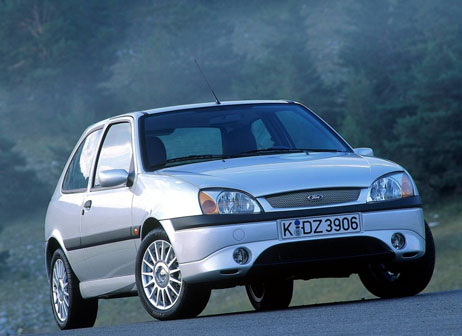 Under the code name "Fiesta 2000" a thoroughly modernized model was presented.
Under the code name "Fiesta 2000" a thoroughly modernized model was presented.
Usually, in modernized cars, safety systems are significantly improved. This is what happened with the Fiesta. It uses reinforced beams in the doors and a rigid transverse beam under the instrument panel, absorbing and dissipating the energy of the side impact; the door hinges were also redesigned. In addition to the driver's gas cushion (capacity 30 dm3), which is standard equipment for all car variants, each Fiesta can have a passenger airbag (60 dm3) and side cushions (after 15,5 dm3), located in the outer side profile of the seat backrests. In the event of a frontal collision, the cushion actuators interact with pyrotechnic tensioners and additional seat belt clamps. The Fuel System of the Ford Fiesta has been further improved to ensure greater tightness in the event of a collision.
In the interior of the car, the new front seats with a unified design attract attention, used in Puma and Focus models. Front seats in the three-door version have folding backrests, however, without the possibility of self-swiping, making it easier to take up seats in the rear seats. The floor plate has not changed and the dimensions of the interior have also remained unchanged, therefore, in the car on the front seats is not very spacious. The driver and passenger rub shoulders and elbows against each other. Luggage compartment with capacity 250 dm3 is not opened from inside the car. When the backrest of the rear seat is unfolded, shared in proportions 2/3 – 1/3, has a capacity of ok. 930 dm3.
The styling of the instrument panel has changed. Retains proven white dial instrument cluster on the Sport. New are capacious storage compartments. An interesting fact is the non-smoking version, in which instead of an ashtray there is an additional storage compartment. This model also uses a short sports gear lever.
The selection of engines available in the modernized Fiesta includes, in addition to the existing gasoline power units with capacities 1242, 1299, 1388 cm3 and diesel with a capacity 1753 cm3 also engine 1.6 from Ford Focus enlarged to 74 kW of power and torque 145 Nm. This engine was used in the Sport version. This 16-valve unit has changed the control parameters and used different acoustic modeling of the intake and exhaust system. Quarter-wave pipe used, causing the shift of sound waves, a Helmholtz chamber resonator was placed in the air filter. Intake ducts have a porous surface, thanks to which the bass color of the sound is heard primarily by car users, less outside the vehicle. Additional sound insulation between the engine compartment and the passenger compartment was also used, and a new way of hanging the power unit reduces the transmission of vibrations to the body. As a result of these actions, the Fiesta Sport engine has a bass murmur so chiseled by young amateurs of fast driving.. Specially selected set of gearbox and main gear ratios, as well as a short stroke of the gear lever provide the driver with a better feel for the Fiesta Sport's powertrain. All varieties of the small Ford are equipped with IB5 mechanical gearboxes, in which synthetic oil is used, facilitating the operation of the gearbox at low temperatures.
Optimized existing ford Fiesta wheel suspension design. One of the essential elements of the suspension is the front subframe, whose task is to stiffen the suspension assembly and precisely determine the geometry of the front wheels, led by McPherson columns. Suspension stiffness to balance body roll increased by 41%, m.in. by enlarging the diameter of the stabilizer cross-section from 15 do 17 mm. The rear wheel suspension uses a torsion beam, the stiffness of which has been increased by 42%, with both wheels fixed in such a way as to allow automatic correction of the convergence. The softer spring characteristics of the wheel suspension springs additionally contribute to the considerable comfort of travel (except for the Sport model, in which the stiffness of the suspension springs was increased by 12%). Improved dynamic performance of the Ford Fiesta Sport also required brake reinforcement: ventilated discs with a larger diameter are used in the front wheels, and in the rear drums with a larger diameter. In total, the efforts made by the manufacturer, aimed at catching up with the competition in the field of building a modern chassis for a popular car must be considered successful.

Fiesta Ford 2000
Visited 170 times, 1 visit(s) today